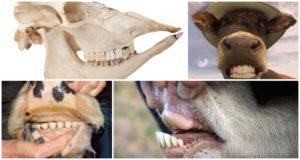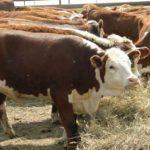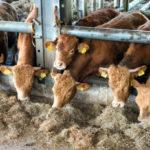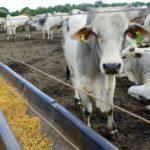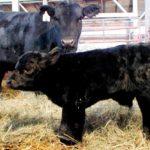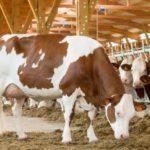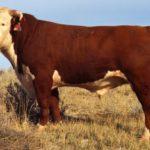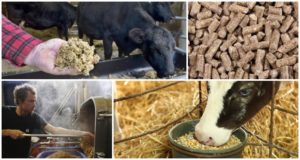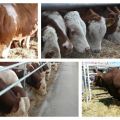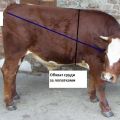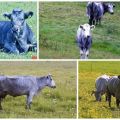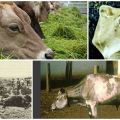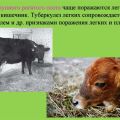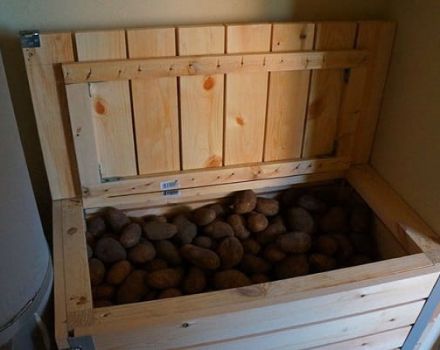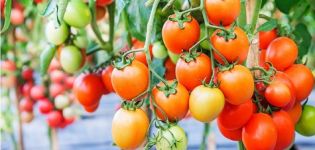2 types of cattle feeding, what food is needed and how to choose calves
Fattening for cattle meat is a system of complex measures used on large livestock, farms, which are aimed at a rapid increase, an increase in live weight of agricultural animals, bringing the livestock to the required weight conditions before slaughter. For fattening they put replacement young growth, culled adults of meat, dairy, milk and meat breeds.
Objectives and technology
The main goals of cattle fattening are to obtain, in the shortest possible time, a large amount of the highest quality meat (beef, veal) with good taste properties at minimum feed costs, and to increase the growth of economic indicators of industrial livestock complexes. It is equally important to achieve a decrease in the share of imports of beef and veal from other countries, to stabilize prices for meat products by reducing the cost of the final product.
Cattle feeding goals:
- increase in body condition of agricultural animals in a short period of time;
- change in the biochemical parameters of the carcass for the better;
- a decrease in the amount of water in the final product, protein compounds in tissues;
- reduction of fatty deposits in the subcutaneous tissue, muscle tissues, on internal organs;
- increasing the slaughter weight of cattle, improving the taste parameters of all parts of the carcass (meat, offal);
- minimization of waste percentages.
The main criterion for raising cattle for meat is live weight. Evaluated at six months, one and a half years of age. In 12-13-month-old calves, the weight should increase 7-8 times compared to their birth weight, and by the age of 17-18 months - 11-13 times.
Intensive livestock raising in our country in specialized farms is carried out according to different methods. Cattle feeding technologies are based on adherence to the feeding regime, competent selection of feed, gradual change in rations, use of a high-quality feed base, and proper organization of feeding grounds.
When fattening agricultural animals on an industrial scale, different rations are used (succulent feed, silage, compound feed, grain).
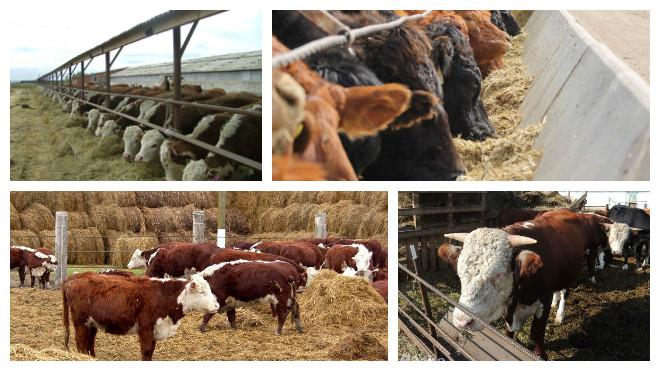
The diet is supplemented with mineral supplements. The increase in nutritional value occurs due to the addition of concentrated feed (grain, juicy), corn silage, high-quality hay to the main feed (grain, juicy).The daily nutrition of cattle must fully cover the energy costs of the body, contain the necessary nutrients, minerals and vitamins in full. When fattening livestock, high quality feed is used.
Important! The structure of rations can change with the course of feeding, to prevent obesity of young animals, adults.
The fattening technology implies stall (in closed premises without walking), stall-pasture, open keeping of cattle at feedlots. Animals are divided into age groups, condition, initial weight, breed. In terms of intensity, growth rate, technologies are classified into:
- extensive, with a long production cycle;
- moderately extensive. The average daily gain is 420-800 g;
- intensive technology, in which the gain in live weight of young animals is 900-1000 g.
The choice of complex measures for keeping the livestock of cattle depends on the climatic conditions of the region, the specialization of livestock complexes, the economic tasks set for the enterprises, the availability of fodder.
How to choose calves for fattening
Young animals of meat, meat and dairy domestic and foreign breeds are most suitable for intensive cultivation. A good increase in live weight is noted in the calves of the Kazakh, Kalmyk, Simmental, Aberdeen Angussians, Hereford, Limousin, Kian, Galloway breeds. They also use cattle of hybrid breeds of zebu-like origin (Brahman, Santa Gertruda).
The setting of bulls for fattening begins immediately after the end of the dairy period, weaning calves from lactating cows. Weaning of young stock is carried out in the fall or at the age of 6-8 months.
Before applying, choosing technologies for intensive rearing, young animals must adapt to new conditions of detention, get used to new feeding rations. On average, this period takes three to five weeks. The feeding period includes two main stages:
- live weight gain, 400-420 kg;
- weight increase up to 650-700 kg.
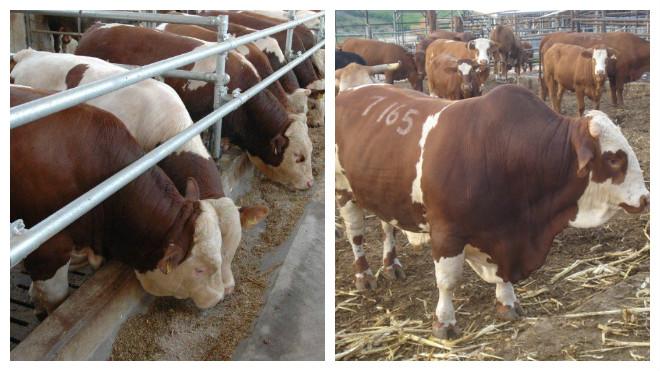
Important! Gobies of meat, combined breeds gain weight faster than heifers. At the age of one, their weight can reach 400-450 kg. Early castration of animals (1-3 months) leads to developmental lag, a decrease in daily weight gain, and early obesity.
In order for calves to have a stable daily increase in live weight, clinically healthy, strong individuals with a normal condition for their age are selected when purchasing or from the general herd. Young animals should have a good gene pool, healthy parents, all the necessary vaccinations. The best period for acquiring young stock is mid to late spring.
Varieties of cattle feeding
There are two types of fattening of young animals, adults:
- Stall (standard). Suitable for all breeds, age groups. It differs in the type of food, rations, depending on the availability of certain feeds, the availability of the feed base, the season.
- Intensive. It is aimed at the rapid building up of muscle mass, achieving high average daily growth rates.
The success of feeding, the choice of measures for intensive cattle rearing depends on:
- sex of animals;
- condition, condition of cows;
- frequency, intensity of feeding, type of feed;
- way of keeping;
- organizing the necessary measures for keeping livestock;
- age;
- genetics, physiological characteristics;
- health conditions;
- growing conditions.
The duration of feeding, regardless of the type, is influenced by the presence of systematic veterinary control, compliance with sanitary and hygienic standards in the barns, a competent approach to the preparation of rations, and the use of high-quality fodder base.
Important! Daily weighing of cattle will help to understand how effective one or another technology is used when choosing a technology for intensive feeding at the enterprise.
On average, it takes 1.2-2 months to feed adults. Young growth with well-organized feeding shows stable daily weight gain.
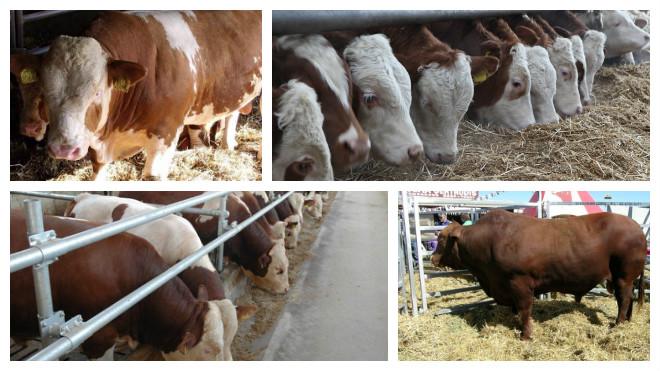
Intensive feeding
Fast, or intensive, fattening of cattle is used to quickly obtain live weight gains in young animals. The method is suitable for raising bulls, heifers of meat, dairy, meat and dairy replacement breeds, as well as calves from the first calving, which appeared when crossing dairy cows and meat bulls-producers. At the exit, meat products have excellent taste characteristics, high nutritional value. The meat is juicy, tender, with a low fat content.
Calf feeding begins after the end of the milk period, the cessation of lactation of cows or upon completion of artificial feeding of newborn animals. The diet consists mainly of hay, cereals, concentrated feed, corn silage. Youngsters are given probiotics, mineral premixes, vitamins.
Stall fattening
Used on farms for fattening cattle of any age, breeds. Includes three stages:
- Initial, lasting one month.
- Intermediate - 40 days.
- Finish - 20 days.
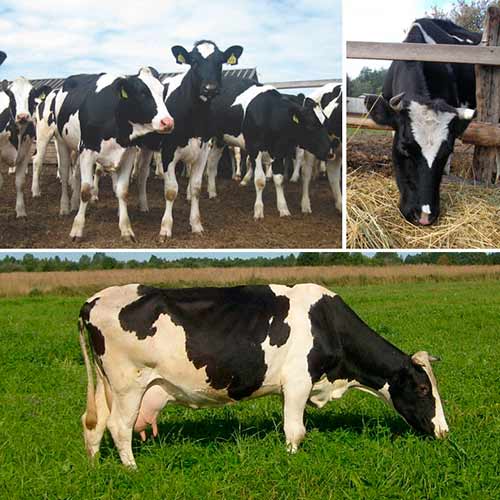
The choice of feed when composing rations is selected separately for each stage of feeding.
Important! Changing diets requires adaptation. The transfer of cows to new feed is carried out gradually.
At the initial stage, it is permissible to use any feed. At the finish line, the bulk of the nutrition is concentrated feed. The daily amount of food is divided into three to four meals. But at the same time, cows must have constant access to drinking water.
What kind of food do you need?
The diet of fattening cattle should be balanced, contain the components necessary for a rapid increase in live weight. According to the composition of the feed, they are basic, mineral, concentrated.
Main
The entire diet of animals is based on the main feed for fattening cattle. Must meet the following parameters:
- have at least 30-35% dry matter;
- contain crude fiber (200 g / kg), crude protein (73-90 g / kg);
- have a sufficient energy value for metabolic processes above 10.5 MJ / kg.
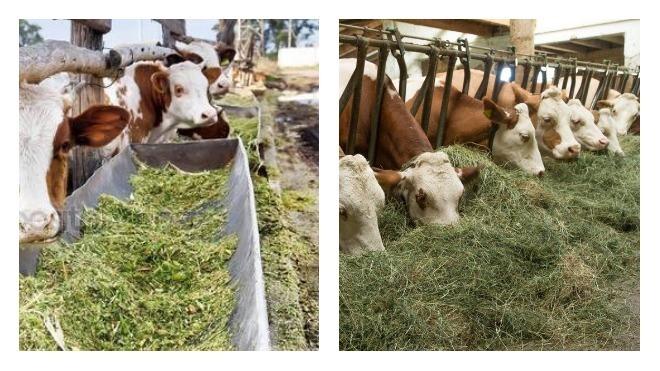
Important! Basic feed should be assimilated by the animal's body by 70-73%, contain biologically active substances necessary for stable gains in live weight.
When compiling rations, the nutritional value and quality of feed are taken into account. If necessary, some feed can be replaced with others. For example, corn silage can be replaced by silage from cereals.
Concentrated
Concentrated feeds are intended to supplement basic cattle diets. They have energy and nutritional value. Contains proteins, vitamins, minerals. Promotes satiety. Have a beneficial effect on metabolism. Compound feeds include: legumes (peas, forage beans), sunflower, rapeseed, soybean meal; wheat grain, oats, barley and dry pulp.
The daily menu should contain at least 2-3 kg of concentrated feed. When drawing up the diet, the period and stage of cattle feeding are taken into account. So, if the weight of young animals does not exceed 400-410 kg, compound feeds occupy 40% of the total volume of dry food. With an increase in body weight, their content gradually decreases.
Mineral
Mineral supplements are added to the daily diet of cattle. They stimulate weight gain, have a positive effect on the growth, development of young animals, increase resistance, the body's immune defense. Minerals accelerate metabolism, stimulate the secretory function of the gastrointestinal tract.
Important! The body of calves needs calcium, phosphorus, potassium, magnesium, sodium.
Mineral supplements are supplemented with special vitamin complexes. The daily norm is 60-80 g.
